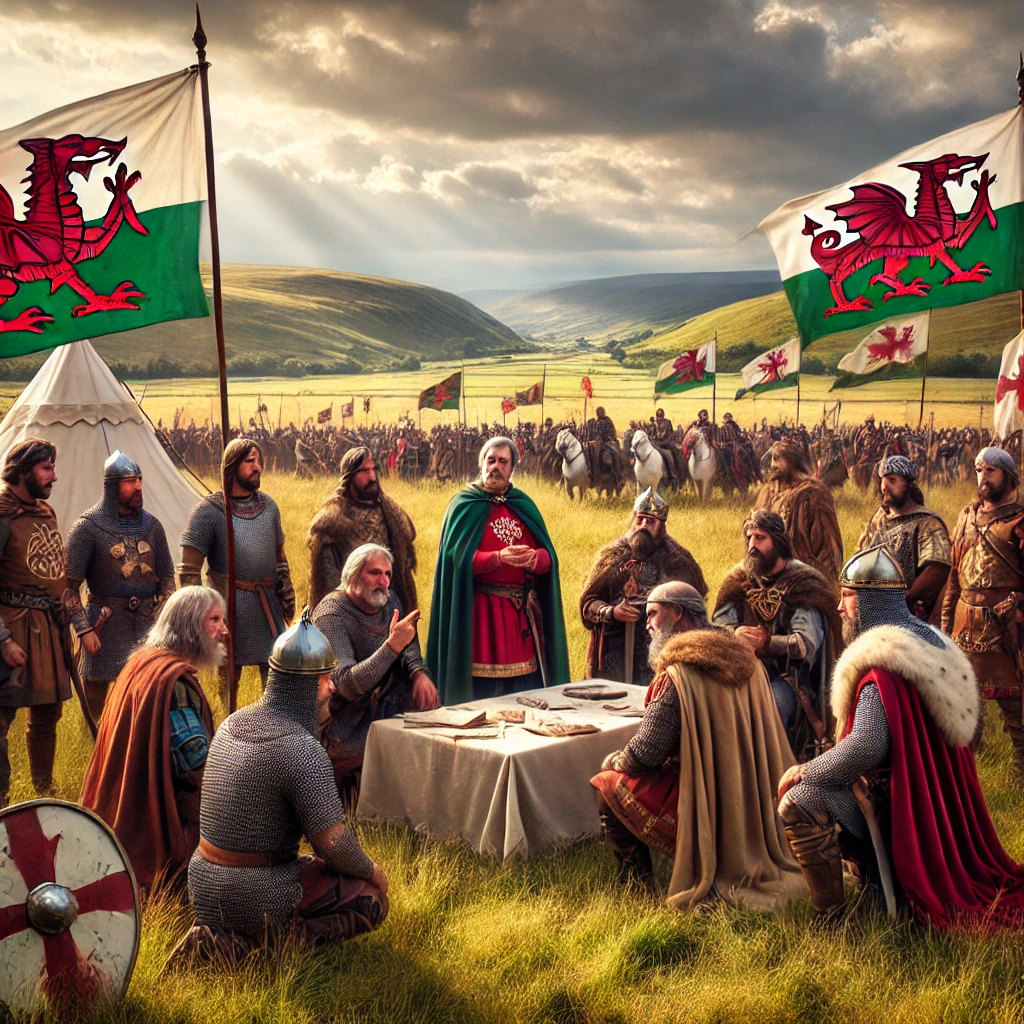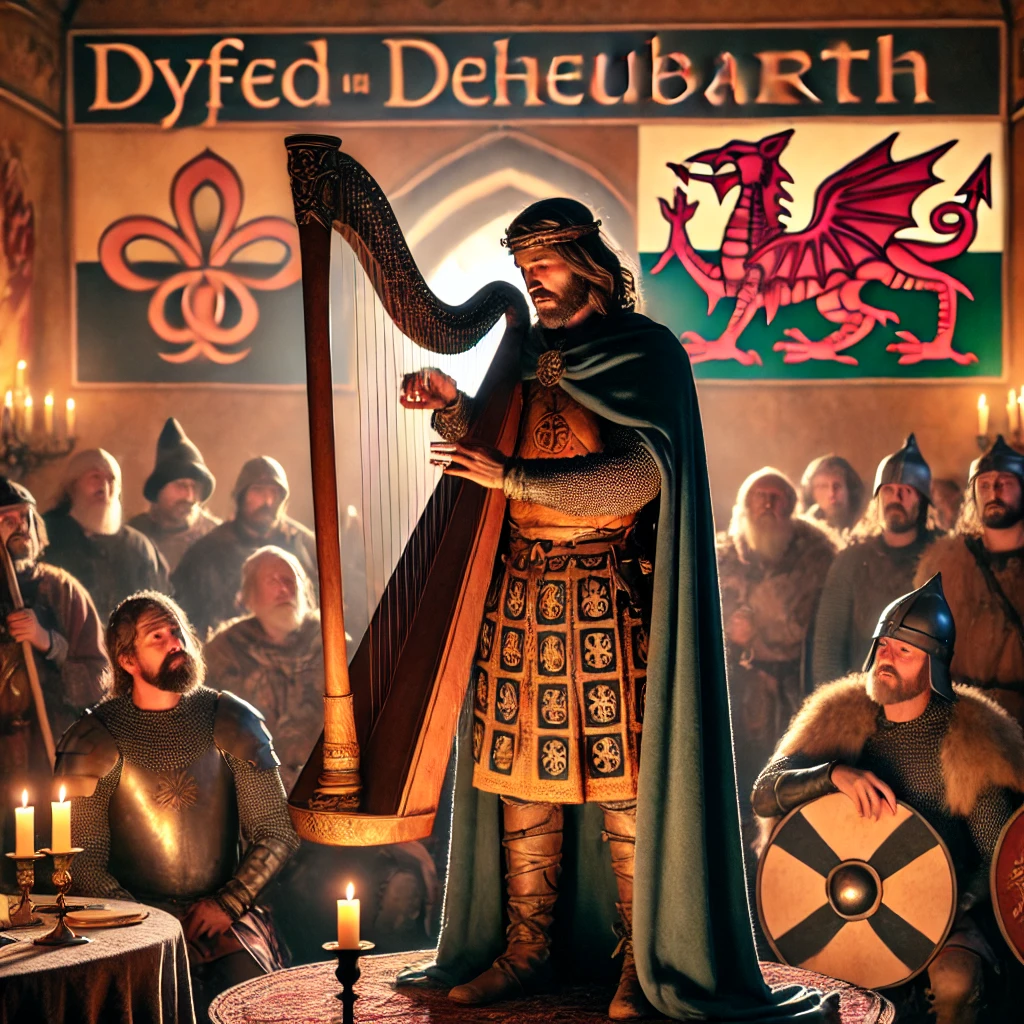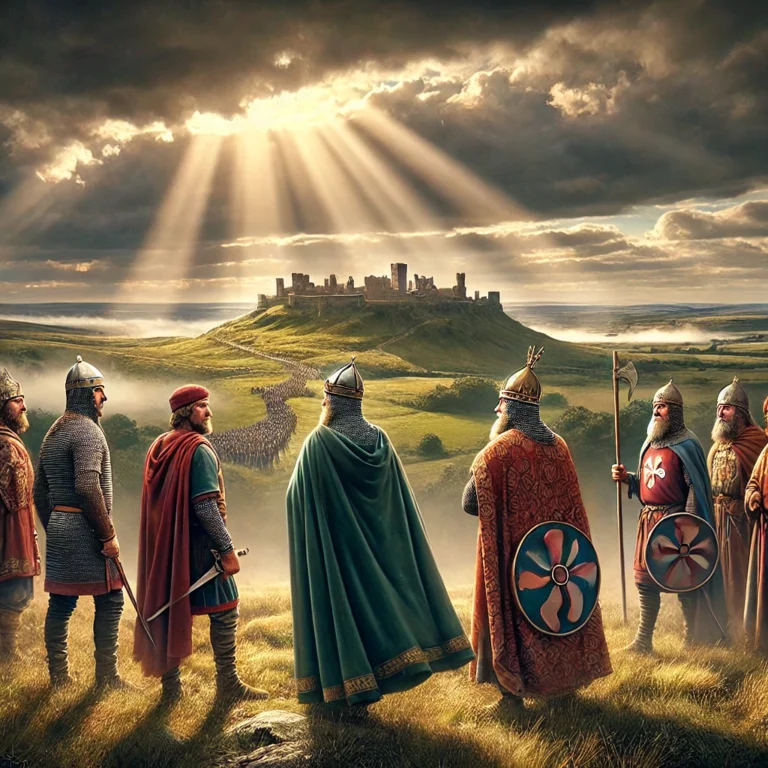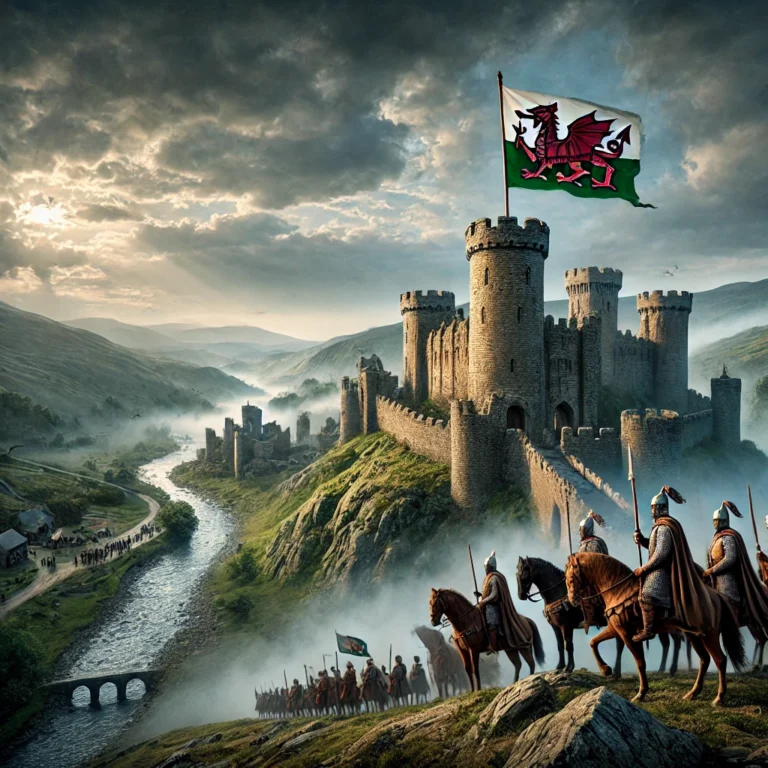Introduction: The Evolution of the Kingdom of Dyfed
The kingdom of Dyfed holds a unique place in the tapestry of Welsh history. Emerging as a powerful and distinct region in the early medieval period, Dyfed’s story is one of resilience, cultural richness, and strategic adaptability. Situated in southwestern Wales, Dyfed was surrounded by natural borders, including rugged coastline and dense forests, which gave it both a defensible position and a sense of separateness from other Welsh territories.
However, as pressures from both internal and external forces increased, Dyfed underwent a significant transformation, merging with the neighbouring region of Seisyllwg to become the more extensive kingdom of Deheubarth.
This evolution, from a self-contained kingdom to a more kingdom unified Welsh realm, reflects the shifting power dynamics in medieval Wales and the emergence of leaders who saw beyond local boundaries. The story of Dyfed’s transformation into Deheubarth provides insight into the forces that shaped Welsh identity, governance, and resistance in the face of external threats. (Period discussed: circa 400–900 AD)
The Early History of the Kingdom of Dyfed
Dyfed’s early development as an independent kingdom was heavily influenced by its Celtic roots, with its people maintaining distinct traditions and governance that set it apart from neighbouring regions.”
— John Davies, author of “A History of Wales”

The kingdom of Dyfed traces its origins back to the Celtic tribes who settled in Wales, bringing with them unique customs, language, and social structures that would shape Welsh society for centuries. Dyfed’s early history is deeply rooted in its Celtic heritage, with its people developing a strong sense of identity and autonomy that would distinguish the region from its Welsh and Anglo-Saxon neighbours.
Unlike the more centralised Anglo-Saxon kingdoms to the east, Dyfed was a loose confederation of local rulers who maintained their independence while sharing a common cultural foundation.
Archaeological findings suggest that Dyfed’s early leaders established small hillforts and settlements to defend against potential invaders and control valuable trade routes along the coast. These leaders, though not kings in the typical medieval sense, were regarded as guardians of Dyfed’s people and traditions.
The rugged terrain of Dyfed played a significant role in fostering this independent spirit, as its natural defences allowed the people to resist external influence and maintain their unique cultural practices.
once you’ve finished with this post, you’ll want to check out my article on the history of powys.
Celtic Foundations and Early Leaders of Dyfed
Dyfed’s early rulers drew heavily on their Celtic roots, which emphasised kinship, honour, and a close relationship with the land. Leaders such as Clydog and Gwrtheyrn—legendary figures in Welsh lore—were celebrated not just for their military skills but for their role in preserving the traditions and values of Dyfed’s people.
These early leaders provided a model of governance that valued local authority, communal decision-making, and the preservation of Welsh language and customs.
This Celtic foundation would later play a pivotal role in Dyfed’s resistance to external pressures, as the people rallied around their leaders in defence of their land and identity. The preservation of Welsh traditions, especially the bardic tradition of storytelling, was central to Dyfed’s early identity and helped establish the kingdom as a cultural bastion within Wales.
The legacy of these early leaders set a precedent for future rulers, who would strive to protect Dyfed’s heritage even as they sought unity with other Welsh territories.
Challenges and External Threats to Dyfed’s Independence
Historical records and archaeological findings indicate that Viking raids in the 9th century targeted coastal regions of Dyfed, leading to fortified defences and shifts in local governance to counter these external threats.
— National Museum Wales, “Viking Raids and Welsh Response”

Despite its strong cultural identity, the kingdom of Dyfed faced continuous threats from external forces that sought to expand their influence over Wales. The 9th century marked the beginning of increased pressure from Viking raiders, who frequently targeted coastal settlements in search of resources and wealth.
These Norse invasions disrupted the stability of Dyfed, forcing its leaders to adopt new defensive measures and consider alliances with neighbouring Welsh kingdoms for mutual protection.
In addition to Viking raids, Dyfed had to contend with the growing power of the Anglo-Saxon kingdoms to the east, particularly Wessex. The Anglo-Saxon threat was more insidious, as it involved not just military incursions but also attempts to spread influence through marriage alliances and diplomacy.
Dyfed’s leaders, aware of the Anglo-Saxon strategy of cultural assimilation, made efforts to reinforce Welsh traditions and resist the cultural encroachment that often accompanied political alliances with their English counterparts.
Viking Raids and Defence Strategies
The Norse incursions into Dyfed were devastating, with Viking raiders often targeting the kingdom’s undefended coastal areas. These attacks forced Dyfed’s leaders to rethink their defensive approach, leading to the construction of small fortifications along vulnerable points on the coast and the formation of local militias to respond quickly to threats.
The people of Dyfed became skilled at guerrilla-style warfare, using their knowledge of the rugged terrain to outmanoeuvre Viking forces and protect their homes.
Some historical accounts suggest that Dyfed’s leaders negotiated with certain Viking factions, offering resources or sanctuary in exchange for protection from further raids.
This pragmatic approach allowed Dyfed to maintain a degree of stability, even as it faced the constant threat of Norse attacks. The resilience of Dyfed’s people in the face of Viking aggression became a source of pride and identity, reinforcing the kingdom’s commitment to self-preservation and autonomy.
Relations with Anglo-Saxon Neighbours
While Viking raids were an immediate and violent threat, the influence of the Anglo-Saxon kingdoms posed a more subtle challenge to Dyfed’s independence.
Wessex, in particular, sought to expand its influence into Wales through strategic marriages and diplomatic overtures. Dyfed’s leaders were cautious in their dealings with Anglo-Saxon neighbours, aware that even a peaceful alliance could lead to cultural erosion and loss of autonomy.
At times, Dyfed would enter into temporary alliances with Wessex to counter Viking incursions, but these alliances were carefully managed to avoid dependency.
Dyfed’s leaders understood that maintaining their kingdom’s identity meant limiting external influence, even if it meant forgoing potential military support. This cautious diplomacy enabled Dyfed to preserve its independence longer than many other regions, resisting the pull of Anglo-Saxon expansion while safeguarding its cultural heritage.
The Influence of Powerful Neighbours: Gwynedd and Seisyllwg
Alliances between Dyfed and Gwynedd were formed out of necessity, as Welsh kingdoms recognised that unity was their best defence against external threats.”
— Professor Wendy Davies, historian of early medieval Wales

As Dyfed faced pressures from external threats, it also had to contend with the ambitions of neighbouring Welsh kingdoms, particularly Gwynedd and Seisyllwg. These kingdoms were themselves strong and independent, with rulers who sought to extend their influence across Wales. Gwynedd, in the north, was the most formidable of the Welsh kingdoms, boasting a powerful military and a lineage of rulers who claimed sovereignty over all of Wales.
Dyfed’s position in the southwest allowed it to maintain a degree of autonomy, but it was clear that alliances with Gwynedd and Seisyllwg could bring both advantages and risks.
Dyfed’s rulers recognised that unity among Welsh kingdoms would be necessary to counter the growing Anglo-Saxon threat. However, forming alliances was not a straightforward matter; each kingdom had its own interests and priorities, and any alliance required careful negotiation. Dyfed’s leaders were skilled diplomats, navigating these relationships to secure their kingdom’s best interests while preserving its independence.
Formation of Strategic Alliances
To protect its borders and ensure the survival of its people, Dyfed occasionally entered into alliances with Gwynedd. These alliances were often based on mutual defence against Viking and Anglo-Saxon incursions, allowing both kingdoms to maintain their independence while benefiting from shared military strength.
However, Dyfed was careful not to become overly reliant on Gwynedd, understanding that alliances could shift rapidly in the volatile Welsh political landscape.
Tensions with Seisyllwg and Power Struggles
While Dyfed was forging alliances with Gwynedd to safeguard its interests, it also faced tensions with the neighbouring kingdom of Seisyllwg to the east. Seisyllwg, like Dyfed, sought to consolidate its power and maintain autonomy amidst external pressures.
However, the close proximity and overlapping spheres of influence inevitably led to competition and, at times, outright conflict. Rulers from each kingdom occasionally sought dominance over the other, leading to fluctuating power dynamics and a persistent rivalry.
The ambitions of both kingdoms set the stage for a series of power struggles that would ultimately lead to a historic transformation. In the mid-9th century, the ruler of Seisyllwg, Rhodri Mawr, married into Dyfed’s royal family, laying the groundwork for a potential unification. This union created a unique opportunity for Rhodri’s descendants, as they now held claims to both kingdoms. Over time, this alliance through marriage would catalyse the formation of a new, more powerful Welsh kingdom, transforming Dyfed’s status and shaping the future of southwestern Wales.
The Rise of Hywel Dda and the Formation of Deheubarth
Hywel Dda’s unification of Dyfed and Seisyllwg under Deheubarth marked a turning point in Welsh governance, with Hywel establishing a code of laws that promoted fairness and justice across the unified realm.
— Welsh Legal History Society, “The Laws of Hywel Dda”

The true transformation of the kingdom of Dyfed came under the rule of Hywel Dda, one of the most influential and respected figures in Welsh history. Hywel, often referred to as “Hywel the Good,” was a visionary leader who sought not only to expand his territory but also to unify and strengthen Welsh governance. As a descendant of both Dyfed and Seisyllwg’s royal families, Hywel inherited claims to both realms, placing him in a unique position to bring them together.
In the early 10th century, Hywel successfully united Dyfed with Seisyllwg, creating the larger and more formidable kingdom of Deheubarth. This unification was more than a mere merging of territories; it represented a shift towards a more cohesive Welsh identity and a step towards resisting the Anglo-Saxon dominance encroaching from the east. Hywel’s consolidation of power allowed him to establish Deheubarth as a significant force in Welsh politics, with influence extending across much of southern and western Wales.
Hywel Dda’s Vision of Unity
Hywel’s unification of Dyfed and Seisyllwg was driven by more than a desire for power. Hywel envisioned a united Welsh realm that could stand strong against external threats and foster internal stability.
His reign is often characterised by an emphasis on law, order, and justice, reflecting his ambition to create a stable, unified Welsh society. His codification of Welsh law, known as Cyfraith Hywel or Hywel’s Law, was a pioneering achievement that promoted fairness and communal responsibility, setting a standard for Welsh governance.
By merging Dyfed and Seisyllwg into Deheubarth, Hywel not only strengthened Welsh political unity but also created a model of governance that valued the rights and welfare of his people.
His emphasis on law and justice became a defining characteristic of Deheubarth, earning him respect and loyalty from his subjects and solidifying his legacy as one of Wales’s most esteemed rulers. Hywel’s vision of unity and governance laid the groundwork for future Welsh leaders, inspiring a sense of national identity and pride that would endure for generations.
The Merger of Dyfed and Seisyllwg into Deheubarth
The creation of Deheubarth through the merger of Dyfed and Seisyllwg was a momentous event in Welsh history. This new kingdom not only signified a shift in power but also marked the beginning of a more unified Welsh front in the face of Anglo-Saxon expansion.
The strategic union allowed Hywel to marshal greater resources, increase military strength, and enhance his influence across Wales.
Hywel’s ability to consolidate power and foster unity without sacrificing the distinct cultural identities of Dyfed and Seisyllwg was a testament to his leadership.
By respecting the unique traditions of each region, Hywel ensured that Deheubarth was more than the sum of its parts; it was a true amalgamation of Welsh identity, culture, and strength. This careful balance of unity and regional pride made Deheubarth resilient and prepared it for the challenges it would face as it sought to defend Welsh independence and sovereignty.
The Cultural Legacy of the Kingdom of Dyfed in Deheubarth
The cultural traditions of Dyfed, especially its bardic heritage, became foundational to the cultural identity of Deheubarth, preserving Welsh language and lore.”
— Geraint Jenkins, author of “The Bardic Tradition in Wales”

Even as Dyfed became part of the larger kingdom of Deheubarth, its cultural legacy continued to shape Welsh identity. Dyfed’s unique traditions, particularly in language, music, and law, were integrated into Deheubarth, helping to preserve Welsh heritage at a time when Anglo-Saxon influence threatened to overshadow local customs.
The merger did not erase Dyfed’s identity; rather, it enriched Deheubarth, bringing a sense of continuity and tradition that strengthened the new kingdom.
The bardic tradition, a hallmark of Welsh culture, flourished in Deheubarth, with bards and poets continuing to celebrate the history, values, and heroes of Dyfed. These bards played a vital role in preserving Welsh language and lore, passing down stories of Dyfed’s leaders, battles, and resilience.
By incorporating Dyfed’s cultural heritage into Deheubarth, Hywel ensured that Welsh identity remained vibrant and enduring, even as political boundaries shifted.
Language, Poetry, and the Bardic Tradition
Dyfed’s commitment to preserving Welsh language and culture found new life in Deheubarth. The bards of Deheubarth carried forward the storytelling traditions of Dyfed, celebrating Welsh heroes and fostering a sense of pride in the kingdom’s past. These poetic and musical traditions became symbols of Welsh resilience, reminding the people of their shared heritage and unbroken connection to the land.
The bardic tradition not only kept the memory of Dyfed alive but also served as a powerful expression of Welsh independence and identity.
The influence of Dyfed’s language and poetry helped Deheubarth become a centre of Welsh culture, attracting scholars, poets, and musicians from across Wales.
This cultural vibrancy strengthened the kingdom’s sense of unity and resistance to external pressures, ensuring that Welsh traditions would not be lost to the forces of assimilation or conquest. Deheubarth’s courts became a hub for the arts, with bards using their talents to reinforce Welsh values and history, creating a lasting cultural legacy.
Dyfed’s Influence on Welsh Governance and Law
The governance principles established in Dyfed continued to influence Deheubarth, particularly through Hywel Dda’s legal reforms. The kingdom of Dyfed had long valued communal responsibility, justice, and respect for local authority, principles that Hywel incorporated into his famous legal code.
This code, which emphasised fairness and the welfare of all citizens, was a reflection of Dyfed’s influence on Deheubarth’s governance and became a foundation for Welsh law.
Hywel’s codification of these principles ensured that Deheubarth was not just a powerful kingdom but a just one, where laws protected the rights of individuals and promoted social harmony.
This focus on justice and governance became one of Deheubarth’s defining characteristics, endearing Hywel to his people and establishing his legacy as a lawgiver. By integrating Dyfed’s values into Deheubarth, Hywel created a lasting model of Welsh governance that would influence future rulers and reinforce Welsh identity.
Key Takeaways
- The kingdom of Dyfed’s journey from independence to its union with Seisyllwg, forming Deheubarth, represents a significant chapter in Welsh history.
- Cultural Legacy: Dyfed’s traditions, governance principles, and bardic heritage enriched Deheubarth, ensuring the preservation of Welsh identity amidst external pressures.
- Influence of Hywel Dda: Hywel’s unification efforts and legal reforms helped shape Deheubarth into a just, resilient kingdom that stood as a model of Welsh unity.
Conclusion: From the Kingdom of Dyfed to a Unified Deheubarth
The transformation of the kingdom of Dyfed into Deheubarth marks a turning point in Welsh history, reflecting the resilience, adaptability, and cultural pride that define the Welsh people. By merging Dyfed’s unique traditions with Seisyllwg, Hywel Dda created a kingdom that symbolised the strength of Welsh identity in the face of external threats.
This journey from a fragmented, independent kingdom to a more unified Welsh realm laid the groundwork for future resistance against Anglo-Saxon dominance and inspired a legacy of unity, justice, and cultural preservation that endures in Wales to this day.
The legacy of Dyfed, preserved through the formation of Deheubarth, remains a testament to the strength and vision of Welsh leaders who sought unity without sacrificing the cultural richness that makes Wales unique. The story of Dyfed’s transformation is a reminder of the power of heritage and the enduring spirit of the Welsh people.
Thanks for your time and reading all about the history of the kingdom of Dyfed.
Matt






